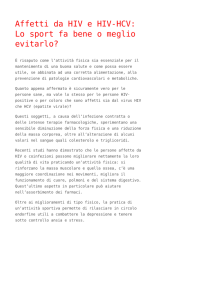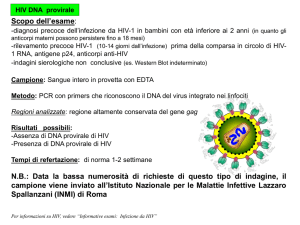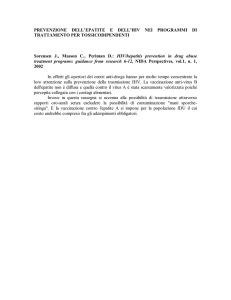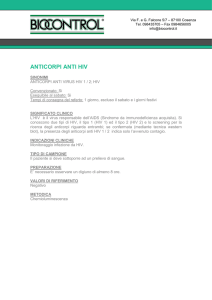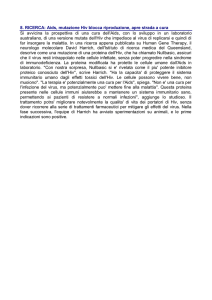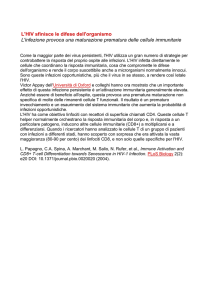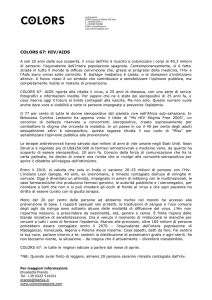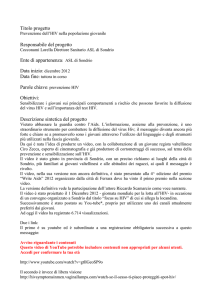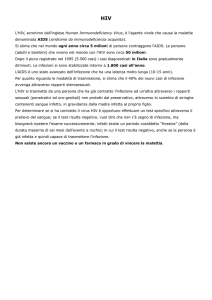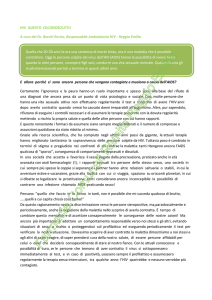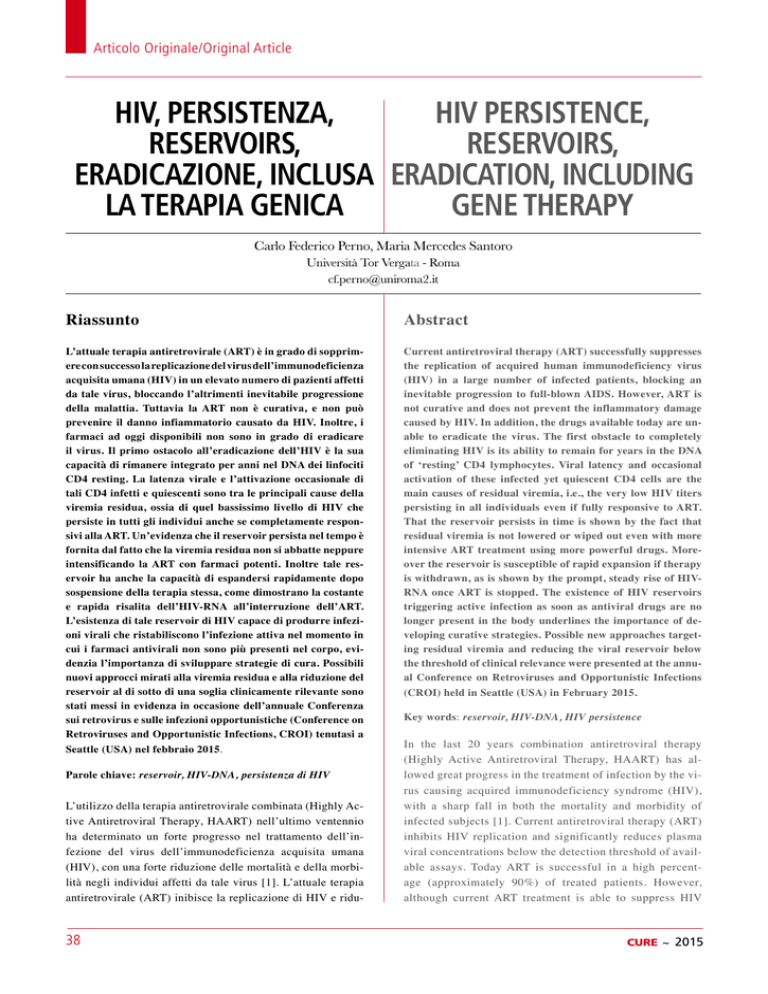
Articolo Originale/Original Article
HIV, persistenza,
HIV Persistence,
reservoirs,
Reservoirs,
eradicazione, inclusa Eradication, including
la terapia genica
Gene Therapy
Carlo Federico Perno, Maria Mercedes Santoro
Università Tor Vergata - Roma
[email protected]
Riassunto
Abstract
L’attuale terapia antiretrovirale (ART) è in grado di sopprimere con successo la replicazione del virus dell’immunodeficienza
acquisita umana (HIV) in un elevato numero di pazienti affetti
da tale virus, bloccando l’altrimenti inevitabile progressione
della malattia. Tuttavia la ART non è curativa, e non può
prevenire il danno infiammatorio causato da HIV. Inoltre, i
farmaci ad oggi disponibili non sono in grado di eradicare
il virus. Il primo ostacolo all’eradicazione dell’HIV è la sua
capacità di rimanere integrato per anni nel DNA dei linfociti
CD4 resting. La latenza virale e l’attivazione occasionale di
tali CD4 infetti e quiescenti sono tra le principali cause della
viremia residua, ossia di quel bassissimo livello di HIV che
persiste in tutti gli individui anche se completamente responsivi alla ART. Un’evidenza che il reservoir persista nel tempo è
fornita dal fatto che la viremia residua non si abbatte neppure
intensificando la ART con farmaci potenti. Inoltre tale reservoir ha anche la capacità di espandersi rapidamente dopo
sospensione della terapia stessa, come dimostrano la costante
e rapida risalita dell’HIV-RNA all’interruzione dell’ART.
L’esistenza di tale reservoir di HIV capace di produrre infezioni virali che ristabiliscono l’infezione attiva nel momento in
cui i farmaci antivirali non sono più presenti nel corpo, evidenzia l’importanza di sviluppare strategie di cura. Possibili
nuovi approcci mirati alla viremia residua e alla riduzione del
reservoir al di sotto di una soglia clinicamente rilevante sono
stati messi in evidenza in occasione dell’annuale Conferenza
sui retrovirus e sulle infezioni opportunistiche (Conference on
Retroviruses and Opportunistic Infections, CROI) tenutasi a
Current antiretroviral therapy (ART) successfully suppresses
the replication of acquired human immunodeficiency virus
(HIV) in a large number of infected patients, blocking an
inevitable progression to full-blown AIDS. However, ART is
not curative and does not prevent the inflammatory damage
caused by HIV. In addition, the drugs available today are unable to eradicate the virus. The first obstacle to completely
eliminating HIV is its ability to remain for years in the DNA
of ‘resting’ CD4 lymphocytes. Viral latency and occasional
activation of these infected yet quiescent CD4 cells are the
main causes of residual viremia, i.e., the very low HIV titers
persisting in all individuals even if fully responsive to ART.
That the reservoir persists in time is shown by the fact that
residual viremia is not lowered or wiped out even with more
intensive ART treatment using more powerful drugs. Moreover the reservoir is susceptible of rapid expansion if therapy
is withdrawn, as is shown by the prompt, steady rise of HIVRNA once ART is stopped. The existence of HIV reservoirs
triggering active infection as soon as antiviral drugs are no
longer present in the body underlines the importance of developing curative strategies. Possible new approaches targeting residual viremia and reducing the viral reservoir below
the threshold of clinical relevance were presented at the annual Conference on Retroviruses and Opportunistic Infections
Seattle (USA) nel febbraio 2015.
Parole chiave: reservoir, HIV-DNA, persistenza di HIV
L’utilizzo della terapia antiretrovirale combinata (Highly Active Antiretroviral Therapy, HAART) nell’ultimo ventennio
ha determinato un forte progresso nel trattamento dell’infezione del virus dell’immunodeficienza acquisita umana
(HIV), con una forte riduzione delle mortalità e della morbilità negli individui affetti da tale virus [1]. L’attuale terapia
antiretrovirale (ART) inibisce la replicazione di HIV e ridu-
38
(CROI) held in Seattle (USA) in February 2015.
Key words: reservoir, HIV-DNA, HIV persistence
In the last 20 years combination antiretroviral therapy
(Highly Active Antiretroviral Therapy, HAART) has allowed great progress in the treatment of infection by the virus causing acquired immunodeficiency syndrome (HIV),
with a sharp fall in both the mortality and morbidity of
infected subjects [1]. Current antiretroviral therapy (ART)
inhibits HIV replication and significantly reduces plasma
viral concentrations below the detection threshold of available assays. Today ART is successful in a high percentage (approximately 90%) of treated patients. However,
although current ART treatment is able to suppress HIV
CURE ~ 2015
Articolo Originale/Original Article
ce significativamente la concentrazione virale nel plasma al
di sotto della soglia di non rilevabilità dei saggi disponibili
per la quantificazione del virus. Oggi la ART funziona con
successo in un elevata percentuale di pazienti trattati (circa il 90%). Tuttavia, sebbene l’attuale ART sia in grado di
sopprimere la replicazione di HIV e bloccare l’altrimenti
inevitabile progressione in AIDS, essa non è curativa, e non
può prevenire il danno infiammatorio causato da HIV. A tal
riguardo, il lavoro presentato da Netanya S. Utay e colleghi
in occasione dell’annuale Conferenza sui retrovirus e sulle
infezioni opportunistiche (Conference on Retroviruses and
Opportunistic Infections, CROI) tenutasi a Seattle (USA) nel
febbraio 2015, ha evidenziato che in individui in infezione
acuta da HIV-1 l’infiammazione, la traslocazione microbica
e la fibrosi rimangono elevate, nonostante un inizio precoce
della ART [2].
Inoltre, nonostante il profondo effetto antivirale della ART,
i farmaci attualmente disponibili non sono in grado di eradicare il virus. Il primo ostacolo all’eradicazione dell’HIV è la
sua capacità di rimanere integrato per anni nel DNA dei linfociti CD4 definiti resting, in quanto si trovano in uno stato
di quiescienza e inattività. Diversi stimoli possono tuttavia
di tanto in tanto “risvegliare” queste cellule, che iniziano
a produrre proteine virali, e quindi permettono al sistema
immunitario di riconoscerle come estranee e di innescare i
meccanismi che porteranno alla loro distruzione. Questo serbatoio virale è piccolo, ma le sue reali dimensioni non sono
note, data la difficoltà nel misurarlo. Le conoscenze acquisite
fino ad oggi portano a concludere che sarebbero necessari
oltre 73 anni di HAART per “ripulire” questo deposito, ma
probabilmente si tratta di una sottostima [3], facendo pensare che l’obiettivo eradicazione completa rimanga pressoché’
irraggiungibile.
La latenza virale e l’attivazione occasionale dei CD4 infetti
e quiescenti sono tra le principali cause della viremia residua, ossia di quel bassissimo livello di HIV che persiste in
tutti gli individui anche se completamente responsivi alla
ART. Un’evidenza che il reservoir persista nel tempo è fornita dal fatto che la viremia residua non si abbatte neppure
intensificando la ART con farmaci potenti. Inoltre tale reservoir ha anche la capacità di espandersi rapidamente dopo
sospensione della terapia stessa, come dimostrano la costante
e rapida risalita dell’HIV-RNA all’interruzione dell’ART e il
fallimento di tutti gli studi che, con schemi e disegni diversi,
hanno verificato la possibilità di interrompere la ART per periodi più o meno brevi.
L’esistenza di reservoir di HIV capaci di produrre infezioni
virali che ristabiliscono l’infezione attiva nel momento in cui
i farmaci antivirali non sono più presenti nel corpo, evidenzia
l’importanza di sviluppare strategie di cura. Il lavoro mostrato
da Jonathan Li e colleghi al CROI 2015 ha messo in evidenza
CURE ~ 2015
replication and block the otherwise inevitable progression
to full-blown AIDS, it is not curative and does not prevent
the inflammatory damage caused by HIV. To this regard,
the study presented by Netanya S. Utay and co-workers at
the annual Conference on Retroviruses and Opportunistic
Infections (CROI), held in Seattle (USA) in February 2015,
found that individuals with acute HIV-1 have persistently
high inflammation, microbial translocation and fibrosis despite the early initiation of ART [2].
Furthermore, despite ART’s far-reaching antiviral effect,
the drugs currently available are unable to eradicate the
virus. The first obstacle to eradicating HIV lies in its ability to remain in the DNA of so-called ‘resting’ or quiescent,
inactive CD4 lymphocytes. These cells can on occasion,
however, be ‘re-awakened’ by a series of different stimuli,
at which they begin producing viral proteins, thereby allowing the immune system to recognize them as foreign
bodies and trigger defense mechanisms leading to their
destruction. Although small, the actual size of this latent
reservoir is not known, quantification being a problem. On
the basis of current understanding though, it has been estimated that it would take more than 73 years of HAART to
‘clean up’ this reservoir. This is probably an underestimation [3], with the result that complete viral eradication is
most likely an unattainable goal.
Viral latency and the occasional activation of infected quiescent CD4 cells are among the main causes of residual
viremia, i.e. the very low HIV titers persisting in all individuals even if fully responsive to ART. That the reservoir
persists in time is shown by the fact that residual viremia
is not lowered or wiped out even with more intensive ART
treatment using more powerful drugs. Moreover, the reservoir can expand rapidly on treatment withdrawal, as has
been shown by the constant and rapid HIV-RNA increases
witnessed on the interruption of ART, as well as by the
failure of all studies, whatever their design or treatment
approach, attempting to withdraw ART for even short periods.
The existence of HIV reservoirs triggering active infection
as soon as antiviral drugs are no longer present in the body
underlines the importance of developing curative strategies. The study presented by Jonathan Li and co-workers
at CROI 2015 evidenced that the higher the cell-associated
HIV-1 RNA and residual viremia values at the time of ART
interruption, the shorter the time to virologic rebound [4].
These findings suggest that cell-associated HIV-1 RNA and
residual viremia could be used as biomarkers to assess the
efficacy of therapies aiming to achieve sustained HIV remission in the absence of ART. Again at CROI 2015, John
Frater and co-workers presented their study along the same
lines in which they looked at 47 individuals enrolled in the
39
Articolo Originale/Original Article
che una più alta concentrazione cellulare di HIV-1 RNA e più
alti valori di viremia residua al tempo dell’interruzione della
ART sono associati in maniera significativa ad un tempo più
breve di rialzo virologico [4]. Tali risultati suggeriscono che
l’HIV-1 RNA cellulare e la viremia residua possono essere
utilizzati come biomarcatori utili per la valutazione dell’efficacia di terapie mirate al raggiungimento di una sostenuta remissione di HIV in assenza di ART. Sulla stessa linea, sempre
al CROI 2015, John Frater e colleghi, tramite una analisi di
47 individui in interruzione terapeutica arruolati allo studio
SPARTAC, hanno mostrato che l’espressione delle molecole
regolatrici PD-1, Lag3 e Tim-3 e la quantità totale di HIV-1
DNA possono aiutare a predire il tempo di rialzo viremico in
pazienti in interruzione terapeutica [5].
Possiamo affermare che con il CROI2015 è migliorata la conoscenza sull’origine della viremia residua e sulla natura e
sulle dimensioni dei reservoir di HIV? Con il CROI 2015
è stato chiarito il ruolo della ART nella riduzione delle dimensioni dei reservoir, anche in prospettiva di prevenire una
riattivazione del virus dopo interruzione terapeutica?
E’ da tenere in considerazione che i reservoir di HIV-1 attivi
durante la terapia costituiscono solo una piccolissima parte
delle cellule infettate dal virus (forse l’1%, o anche meno), la
maggior delle quali contiene virus difettivo, con grandi delezioni interne o ipermutazioni da G ad A mediate dalla proteina cellulare APOBEC. Per queste ragioni, per ben definire la
grandezza reale del reservoir patogeneticamente rilevante, si
rende necessario sia caratterizzare i ceppi provirali in grado
di produrre virus replicanti, sia definire correttamente le cellule produttrici HIV.
Sebbene il genoma di HIV-1 contenga mutazioni letali, le
sequenze regolatrici LTR (Long Terminal Repeat), coinvolte nella trascrizione, nell’integrazione e nel controllo
dell’espressione del genoma virale, possono rimanere intatte,
indicando che l’HIV-1 RNA può ancora essere ancora trascritto. In linea con questa considerazione, lo studio presentato da Ya-Chi Ho al CROI 2015 ha mostrato che provirus di
HIV-1 difettivi possono essere trascritti durante l’inversione
della latenza e che le cellule che contengono tali provirus difettivi possono espandersi durante l’attivazione dei linfociti
T [6]. La trascrizione dell’HIV-RNA da provirus difettivi può
precludere dunque una corretta misurazione della quantità
del reservoir latente ed il suo ruolo nella patogenesi.
Gli studi di Mary F. Kearney e Marta E. Bull presentati al
CROI 2015 sono stati mirati a cercare di definire se l’espressione di HIV-1 durante il trattamento fosse dovuta ad una
spontanea riattivazione dalla latenza o ad una continua trascrizione virale, seppur a bassi livelli [7,8]. In entrambi gli
studi sono stati comparati l’HIV-1 RNA cellulare, l’HIV-1
DNA cellulare e l’HIV-1 RNA plasmatico, tramite il test del
single genome. I risultati emersi da entrambi gli studi hanno
40
SPARTAC trial who had interrupted HIV treatment. The
authors found that the expression of the regulatory molecules PD-1, Lag3 and Tim-3 as well as total HIV-1 DNA
can help predict the virologic rebound time interval in patients suspending treatment [5].
Did it transpire at CROI 2015 that we now have a better
knowledge of the origin of residual viremia and the nature
and size of the HIV reservoir? Did the Conference clarify
the role of ART in reducing reservoirs, also with a view
to preventing virus reactivation following treatment interruption?
It should be borne in mind that the HIV-1 reservoirs active
even during therapy are only a very small component of
the overall number of virus-infected cells – perhaps 1% or
even less. Most infected cells contain defective virus with
large internal deletions or G to A hypermutations mediated
by the cellular protein APOBEC. This is why if the true
order of magnitude of the pathogenically relevant reservoir
is to be accurately defined, the proviral strains able to produce replicating virus must be characterized and the HIV
producing cells correctly defined.
Although the HIV-1 genome contains lethal mutations,
the LTR (Long Terminal Repeat) regulatory sequences involved in the transcription, integration and control of viral
genome expression can remain intact, with the result that
HIV-1 RNA can still be transcribed. The study presented
by Ya-Chi Ho at CROI 2015 shows that defective HIV-1
proviruses can be transcribed when latency is reversed, and
that cells containing defective proviruses can expand during lymphocyte T activation [6]. Transcription of HIV-RNA
by defective proviruses can therefore hinder correct quantification of the latent reservoir and its pathogenic role.
Studies presented by Mary F. Kearney and Marta E. Bull
at CROI 2015 aimed to define whether HIV-1 expression
during treatment is due to spontaneous reversal of latency
or to continued - albeit low-level - viral transcription [7,8].
Both studies compared cell-associated HIV-1 RNA, HIV1 DNA and plasma HIV-1 RNA using the single genome
test. Both confirmed that low-level viremias or blips often
originate from proliferating cells induced to transcribe proviral sequences, and that continuous replication and viral
evolution are observed even if on-going therapy maintains
viral levels under the detectability threshold. Bull and coworkers also reported that in many cases the presence of
defective proviral strains can produce viremia with the infection of new cells [8], thereby confirming the data presented by Ho [6].
Francesco Simonetti and co-workers from Frank Maldarelli’s group at NIH elegantly described the first case of residual viremia associated with expanded cells carrying a
specific intact HIV provirus [9]. On analyzing 317 HIV
CURE ~ 2015
Articolo Originale/Original Article
confermato che i bassi livelli di viremia o i blips spesso si
originano da cellule in proliferazione indotte a trascrivere
sequenze provirali, e che una continua replicazione ed evoluzione virale può essere osservata nonostante la terapia in atto
mantenga i livelli del virus al di sotto della soglia di non rilevabilità. Bull e colleghi hanno anche riportato che in molti
casi la presenza di ceppi provirali difettivi può produrre una
viremia senza infezione di nuove cellule [8], confermando in
questo modo i dati presentati da Ho [6].
Francesco Simonetti e colleghi, del gruppo di Frank Maldarelli all’NIH, hanno elegantemente descritto il primo caso
di viremia residua associata con un’espansione di cellule
contenenti un singolo specifico provirus di HIV intatto [9].
Dall’analisi di 317 sequenze di HIV da plasma, cellule mononucleate di sangue periferico (PBMC, peripheral blood mononuclear cell), milza, linfonodi e tessuti tumorali infiltrati
con linfociti T CD4 + e T CD8 +, gli autori hanno scoperto
che le varianti di HIV erano omogeneamente intersperse nel
sangue e nei tessuti, e non vi era alcuna evidenza di replicazione localizzata. Un solo provirus era la causa della maggior
parte dell’HIV-RNA rilevato nel plasma. Le cellule di questo
clone erano accumulate specificamente nelle metastasi tumorali, suggerendo che lo stimolo immunitario, così come gli
antigeni tumorali, possono contribuire all’espansione delle
cellule, e forse all’attivazione del provirus e al rilascio dei
virioni nel plasma [9].
Studi recenti hanno evidenziato come i siti di integrazione
di HIV giochino un ruolo fondamentale sull’espansione e la
persistenza di cellule infettate [10-13]. A tal riguardo, Frank
Maldarelli, Stephen Hughes e colleghi hanno identificato
più di 2500 siti di integrazione nei PBMC e nelle cellule T
CD4+ di individui infetti sotto ART, circa il 40% dei quali
era localizzato in cloni di cellule espanse [10,12]. In un individuo, circa il 50% delle cellule infettate originava da un
singolo clone, e alcuni cloni persistevano per più di 10 anni.
Gli autori hanno trovato integrazioni multiple indipendenti
in diversi geni, tra cui MKL2 e BACH2 (geni coinvolti nella
regolazione della crescita cellulare), molte delle quali si trovavano in cellule espanse [10,12]. I riarrangiamenti del DNA
che coinvolgono questi geni sono presenti in tumori umani.
Questi risultati hanno importanti implicazioni per lo sviluppo
ed il mantenimento del reservoir virale, per il disegno e l’implementazione di strategie mirate ad eliminare l’infezione
persistente di HIV, per l’uso di vettori lentivirali nella terapia genica, ed eventualmente per una migliore comprensione
dell’origine di alcuni tumori relazionati all’HIV.
Infine, è noto che nelle primissime settimane dell’infezione
primaria HIV stabilisce un reservoir latente nei linfociti T
CD4+ in stato di riposo ed inattività. Al fine di determinare
l’impatto della somministrazione immediata della terapia antiretrovirale sul decadimento dell’HIV-DNA nell’uomo, Jade
CURE ~ 2015
sequences from plasma, PBMC (peripheral blood mononuclear cells), spleen, lymph nodes and tumor-infiltrating
T CD4 + and T CD8 + lymphocytes, the authors found
that the HIV variants were evenly distributed in blood and
tissues and that there was no evidence of localized replication. Just one provirus was the cause of most of the
HIV-RNA found in plasma. The cells of this clone were
specifically found in tumor metastases, suggesting that an
immune stimulus, like tumor antigens, may contribute to
cell expansion and perhaps provirus activation, with the
release of virions into plasma [9].
Recent studies have shown that specific HIV integration
sites play a major role in the clonal expansion and persistence of infected cells [10-13]. To this regard, Frank Maldarelli, Stephen Hughes and co-workers have identified
more than 2500 integration sites in PBMC and T CD4+
cells of infected individuals undergoing ART treatment,
approximately 40% of which are located in expanded cell
clones [10,12]. Approximately 50% of the infected cells in
one patient were from one single clone, and some clones
persisted for more than 10 years. There were multiple independent integrations in several genes, including MKL2
and BACH2; many of these integrations were in clonally
expanded cells [10,12]. The DNA rearrangements involving these genes are present in human tumors. These findings have important implications for the development and
maintenance of the viral reservoir, for the design and implementation of ad hoc strategies to eliminate persistent
HIV infection, and for the use of lentiviral vectors in gene
therapy and, eventually, for a better understanding of the
origin of some HIV-related tumors.
Finally, it is known that in the very first weeks of primary infection, HIV establishes a latent reservoir in resting,
inactive T CD4+ lymphocytes. In order to determine the
impact of immediate antiretroviral therapy on HIV-DNA
decay in man, Jade Ghosn and co-workers measured 1305
PMMC HIV-DNA samples from 327 subjects with primary
infection enrolled in the PRIMO cohort who had started
ART therapy within one month of enrollment, achieving a
viral load of less than 50 copies/ml in the first 6 months of
treatment [14]. The quantitative data allowed the authors
to conclude that HIV-DNA decay in the first 8 months of
treatment is much more rapid in those individuals who had
started therapy within 15 days of contracting the infection.
Decay rates were found to be slower in individuals who
initiated ART one month after becoming infected. Decay
rates were even lower when therapy was started within 3
months following initial infection. Moreover, even after
5 years of successful ART therapy (i.e. with plasma viral
loads continually below 50 copies/ml), the patient group
that had started ART within 15 days of infection had a low-
41
Articolo Originale/Original Article
Ghosn e colleghi hanno effettuato 1305 misurazioni di HIVDNA da PBMC di 327 individui in infezione primaria arruolati alla coorte PRIMO che iniziavano una ART entro il primo mese dall’arruolamento e che raggiungevano una carica
virale al di sotto le 50 copie/mL nei primi sei mesi di trattamento [14]. Tali misurazioni hanno permesso di stimare che
il declino dell’HIV-DNA nei primi otto mesi di trattamento è
molto più rapido in quegli individui che avevano iniziato la
terapia entro 15 giorni dall’infezione. I tassi di decadimento risultavano più lenti in individui che avevano iniziato la
ART solo dopo un mese dall’infezione, ed erano ancor meno
sostenuti in coloro che iniziavano la terapia entro tre mesi
dall’infezione. Inoltre, dopo cinque anni di ART sempre in
successo (quindi con carica virale plasmatica sempre al di
sotto delle 50 copie/mL), il gruppo di pazienti che aveva iniziato la ART entro 15 giorni dall’infezione aveva la media
di HIV-DNA intracellulare più bassa rispetto al gruppo che
iniziava la terapia dopo tre mesi dall’infezione (1,62 vs. 2,24
log10 copie/milioni di PBMC, p=0,0006) [14]. Tutti questi risultati sono a supporto di un inizio della ART il più rapido
possibile, immediatamente dopo l’infezione, e dunque sono
in favore anche di uno screening precoce dell’infezione.
In conclusione, molte delle ricerche presentate all’ultimo
CROI sono state finalizzate ad una migliore comprensione
e caratterizzazione della persistenza dei reservoir latenti di
HIV nel corpo, anche negli individui trattati con ART. Nonostante siamo ancora lontani dal raggiungere risultati clinicamente rilevanti, tuttavia tutti gli studi discussi sono di notevole interesse, in quanto indicano possibili nuovi approcci
mirati alla viremia residua e alla riduzione del reservoir al di
sotto di una soglia clinicamente rilevante.
42
er average intracellular HIV-DNA compared to the group
starting treatment 3 months after becoming infected (1.62
vs. 2.24 log 10 copies/millions of PBMC, p=0.0006) [14].
All these findings support initiating ART treatment as early
as possible following infection, and consequently, strongly
advocate early screening for infection.
In conclusion, many of the studies presented at this year’s
CROI aimed to improve our understanding and ability to
characterize persistent latent HIV reservoirs in the body
even in individuals undergoing ART. Even if we are far
from achieving clinically significant results, the studies
presented were all of considerable interest, indicating possible new approaches to residual viremia and reducing the
reservoir below clinically detectable thresholds.
CURE ~ 2015
Articolo Originale/Original Article
REFERENCES
1.
Antiretroviral Therapy Cohort Collaboration. Life expectancy of individuals on combination antiretroviral therapy in high-income
2.
NS Utay, J Ananworanich, B Slike, N Michael, S Pinyakorn, D Sutthichom, S Puttamaswin, D Douek, I Sereti, A Rupert. Inflammation
countries: a collaborative analysis of 14 cohort studies. Lancet. Jul 26 2008;372(9635):293-299.
Persists Despite Early Initiation of ART in Acute HIV Infection. 2015 Conference on Retroviruses and Opportunistic Infections.
Seattle, February 23-24, 2015. Abstract 47.
3.
JD Siliciano, J Kajdas, D Finzi, TC Quinn, K Chadwick, JB Margolick, C Kovacs, SJ Gange, RF Siliciano. Long-term follow-up studies
4.
B Etemad, H Ahmed, E Aga, R Bosch, JW Mellors, D Kuritzkes, M Para, RT Gandhi, J Li. The Size of the Active HIV Reservoir
confirm the stability of the latent reservoir for HIV-1 in resting CD4+ T cells. Nat Med. 2003 Jun;9(6):727-8. Epub 2003 May 18.
Predicts Timing of Viral Rebound. 2015 Conference on Retroviruses and Opportunistic Infections. Seattle, February 23-24, 2015.
Abstract 110LB.
5.
J Hurst, J Williams, JP Thornhill, M Pace, C Willberg, E Hamlyn, A Babiker, R Phillips, S Fidler, J Frater. Biomarkers to Predict Viral
Rebound at Antiretroviral Therapy Interruption in SPARTAC. 2015 Conference on Retroviruses and Opportunistic Infections. Seattle,
February 23-24, 2015. Abstract 111LB
6.
YC Ho, R Pollack, P Yong, RF Siliciano. Defective HIV-1 Proviruses Can Be Transcribed Upon Activation. 2015 Conference on
7.
A Wiegand, J Spindler, W Shao, F Hong, AR Cillo, E Halvas, E Fyne, JM Coffin, JW Mellors, MF Kearney. Analysis of HIV RNA
Retroviruses and Opportunistic Infections. Seattle, February 23-24, 2015. Abstract 392
in Single Cells Reveals Clonal Expansions and Defective Genomes. 2015 Conference on Retroviruses and Opportunistic Infections.
Seattle, February 23-24, 2015. Abstract 106.
8.
ME Bull, J Mullins, L Frenkel, S McLaughlin, H Huang, S Styrchak, J Soria, E Ticona, A La Rosa, C Mitchell. Low-Level HIV
Viremias Originate in Part From Infected Proliferating Cells. 2015 Conference on Retroviruses and Opportunistic Infections. Seattle,
February 23-24, 2015. Abstract 107.
9.
F Simonetti, S Hill, X Wu, S Hughes, F Maldarelli, M Sobolowski, E Fyne, J Mellors, W Shao, J Coffin. Residual Viremia Caused by
Clonally Expanded Tumor-Infiltrating CD4+ Cells. 2015 Conference on Retroviruses and Opportunistic Infections. Seattle, February
23-24, 2015. Abstract 105.
10. F Maldarelli, X Wu, L Su, FR Simonetti, W Shao, S Hill, J Spindler, AL Ferris, JW Mellors, F Kearney, JM Coffin, SH Hughes.
HIV latency. Specific HIV integration sites are linked to clonal expansion and persistence of infected cells. Science. 2014 Jul
11;345(6193):179-83. doi: 10.1126/science.1254194. Epub 2014 Jun 26.
11. TA Wagner, S McLaughlin, K Garg, CY Cheung, BB Larsen, S Styrchak, HC Huang, PT Edlefsen, JI Mullins, LM Frenkel. HIV latency.
Proliferation of cells with HIV integrated into cancer genes contributes to persistent infection. Science. 2014 Aug 1;345(6196):570-3.
doi: 10.1126/science.1256304. Epub 2014 Jul 10.
12. Stephen H. Hughes Specific HIV Integration Sites Linked to Clonal Expansion and Persistence of Cells. 2015 Conference on
Retroviruses and Opportunistic Infections. Seattle, February 23-24, 2015. Abstract 21.
13. S Laufs, D Schenkwein, N Kootstra, FA Giordano, C Stephan, HG Kraeusslich, W Kern, S Usadel, M Schmidt, Cvon Kalle. Large-
Scale Analysis of HIV-1 Integration Sites in Untreated and Treated Patients. 2015 Conference on Retroviruses and Opportunistic
Infections. Seattle, February 23-24, 2015. Abstract 381.
14. M Laanani, J Ghosn, A Essat, A Mélard, R Seng, E Mortier, C Goujard, L Meyer, C Rouzioux. The Earlier cART Is Initiated During
PHI, the More Intracellular HIV-DNA Decreases. 2015 Conference on Retroviruses and Opportunistic Infections. Seattle, February
23-24, 2015. Abstract 373.
CURE ~ 2015
43

